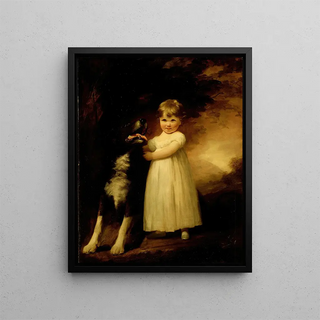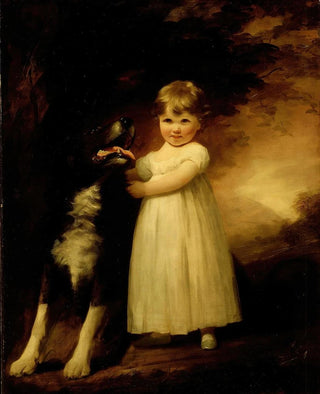Art print | Eleanor Margaret Gibson-Carmichael - Sir Henry Raeburn


View from behind

Frame (optional)
In the vast panorama of art history, some works stand out for their ability to capture not only the essence of a moment but also the soul of the characters depicted. The art print Eleanor Margaret Gibson-Carmichael - Sir Henry Raeburn is one of those pieces that, through its depth and delicacy, invites the viewer on a journey through time. This painting, imbued with nostalgia and sophistication, evokes an era when art was not only a means of expression but also a reflection of the values and aspirations of a society in full transformation. The representation of Gibson-Carmichael, with her penetrating gaze and elegant posture, immerses us in the intimacy of a prominent figure of her time, while offering a window into Sir Henry Raeburn's artistic universe.
Style and uniqueness of the work
Sir Henry Raeburn's style is immediately recognizable, characterized by an undisputed mastery of light and shadow, as well as meticulous attention to detail. In this piece, Raeburn manages to combine realism and idealization, creating a subtle balance between faithful representation of the subject and a certain heroic grandeur. The chosen color palette, both rich and nuanced, evokes an atmosphere of serenity and dignity. The drapery of the clothing, carefully rendered, almost seems to vibrate under the light, adding a tactile dimension to the painting. Gibson-Carmichael's posture, both natural and posed, demonstrates a quiet confidence, while her delicate expression suggests emotional depth that leaves no one indifferent. This work stands out not only for its technique but also for how it captures the spirit of an era, offering a reflection on identity and social status.
The artist and his influence
Sir Henry Raeburn, an emblematic figure of 18th-century Scottish painting, knew how to mark his time with a unique style that combines tradition and modernity. Influenced by the great European masters, he developed a personal approach, emphasizing the psychology of the characters he portrayed. His portraits, often commissioned by members of high society, are testimonies of an era

Matte finish

View from behind

Frame (optional)
In the vast panorama of art history, some works stand out for their ability to capture not only the essence of a moment but also the soul of the characters depicted. The art print Eleanor Margaret Gibson-Carmichael - Sir Henry Raeburn is one of those pieces that, through its depth and delicacy, invites the viewer on a journey through time. This painting, imbued with nostalgia and sophistication, evokes an era when art was not only a means of expression but also a reflection of the values and aspirations of a society in full transformation. The representation of Gibson-Carmichael, with her penetrating gaze and elegant posture, immerses us in the intimacy of a prominent figure of her time, while offering a window into Sir Henry Raeburn's artistic universe.
Style and uniqueness of the work
Sir Henry Raeburn's style is immediately recognizable, characterized by an undisputed mastery of light and shadow, as well as meticulous attention to detail. In this piece, Raeburn manages to combine realism and idealization, creating a subtle balance between faithful representation of the subject and a certain heroic grandeur. The chosen color palette, both rich and nuanced, evokes an atmosphere of serenity and dignity. The drapery of the clothing, carefully rendered, almost seems to vibrate under the light, adding a tactile dimension to the painting. Gibson-Carmichael's posture, both natural and posed, demonstrates a quiet confidence, while her delicate expression suggests emotional depth that leaves no one indifferent. This work stands out not only for its technique but also for how it captures the spirit of an era, offering a reflection on identity and social status.
The artist and his influence
Sir Henry Raeburn, an emblematic figure of 18th-century Scottish painting, knew how to mark his time with a unique style that combines tradition and modernity. Influenced by the great European masters, he developed a personal approach, emphasizing the psychology of the characters he portrayed. His portraits, often commissioned by members of high society, are testimonies of an era






